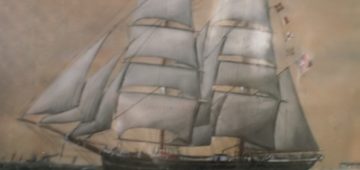Seafarers of the 1960s and early 1970s, serving on general cargo ships, are sure to have nostalgic memories of the East African Coast. Before the days of containerization and the introduction of container feeder vessels, it was common to call at a full range of East African Ports, topping up or delivering numerous parcels of cargo. Port stays could be short and others long by today’s standards.
My memories come rushing back to my Bank Line days, whilst serving as an apprentice on the Weybank (built 1945) and then the Levernbank (built 1961) during the 1960s. On both ships I regularly called at East African Ports.
For over 2 years I was employed on the Orient-Africa Liner Service on the Levernbank, a gem of a run, between Japan, Taiwan, Philippines, Hong Kong, Bangkok, Singapore and the full scope of East African Ports, basically ranging between Mombasa and Cape Town. This was a fast service for those days, the ship operating at 16 knots, when fuel was still relatively cheap, and it was economically viable to operate ships at their full design speeds.
Much of my sixteen months on the Weybank was spent doing a steady 11 knots, running between Calcutta, Madras, Colombo, Mombasa, Dar-es-Salaam, Beira and Lourenco Marques, commonly known within the company as the India-Africa Service.
My entire time trading along the East African coast is filled with exhilarating and graphic reminiscences, and a complete compendium of golden memories, while engaged on a great run, when ships were still ships, each with their individual character and trait.

At the major African Ports, such as Mombasa, Lourenco Marques, Durban, and Cape Town, it was not unusual to experience port stays exceeding one week, whilst at secondary ports it was generally limited to just a single day. At the other end of the spectrum, in India port stays could be up to six weeks in Calcutta, with Madras and Colombo, thankfully somewhat less.
In the Far East we also enjoyed good Port time but a better turnround was the norm. A month was spent coasting around Japan, typically several days each at such places as Nagasaki, Moji, Kobe, Osaka, Nagoya and Yokohama, always followed by a good 2 or 3 days at least in Hong Kong, Keelung, Kaohsiung, Bangkok, Singapore, and Port Swettenham, nowadays called Port Klang. Visits to Philippines or Borneo ports were somewhat shorter by comparison. We also made occasional calls at Mauritius and Reunion, in the Indian Ocean. On the Orient Africa Line, a round trip, say from Hong Kong back to Hong Kong was a tad over 3 months, as regular as clockwork. The run was so cherished, no one wished to leave the vessel and it was not unknown for some to volunteer and sign on for “double headers”. In my case I was particularly fortunate because my residence was in Hong Kong, so I could look forward to being home for a few days, at least every 3 months.
The term ‘East African Coast’ is generally used for the region between the River Rovuma which form the border between Mozambique and Tanzania in the south and the River Juba which marks the border between Kenya and Somalia in the north, spanning a distance of approximately 1,000 nautical miles.
The East African Coast included such ports as Kilwa, Zanzibar, Pemba, Mombasa, Mtwara, Malindi, Tanga, Ungwana and anchorages in the Lamu Archipelago (Manda, Shanga, Pate and Lamu). Of course, there were other tiny locations where ships just anchored or secured to a buoy, close to the coast and the various cargo was brought out by surf boats or barges. Then there was the Mozambique coast with its ports of Beira and Lourenco Marques, both with their strong Portuguese influence, not forgetting to mention the South African Natal coast, a little further south, featuring the delightful and beautiful port of Durban. These few ports warrant a story of their own, another day.
From personal memories, the East African Coast

Subscribe today to read the full article!
Simply click below to subscribe and not only read the full article instantly, but gain unparalleled access to the specialist magazine for shipping enthusiasts.




Comments
Sorry, comments are closed for this item